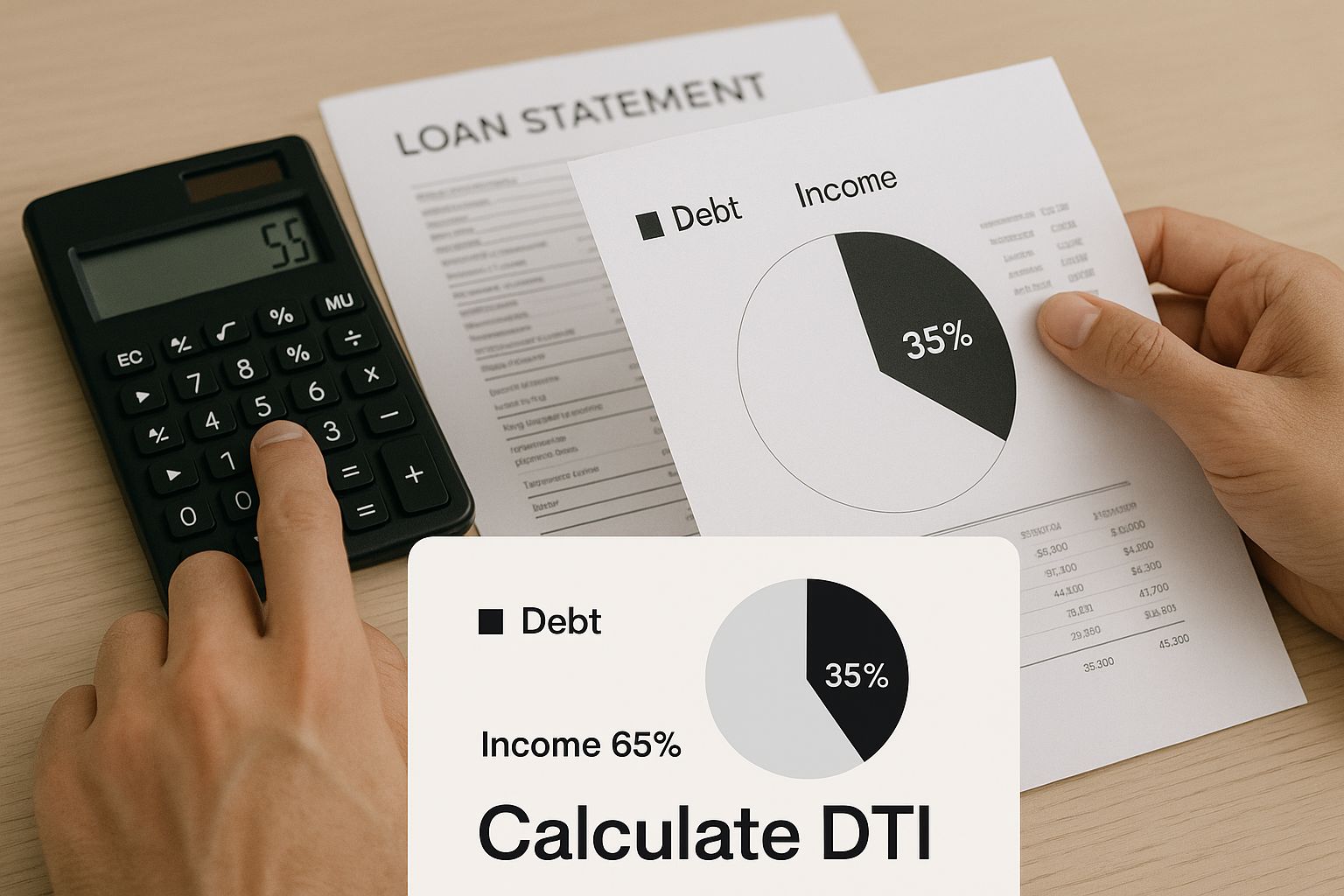Income Requirements for a VA Loan: What You Need to Know
November 19, 2025
Learn about the income requirements for a VA loan and how to qualify. Get the essential facts to boost your chances of approval today!

Let's get one of the biggest VA loan myths out of the way right now: there is no magic number, no specific salary you have to earn to get approved. It’s a common misconception, but the truth is, the Department of Veterans Affairs doesn't set a minimum income requirement.
Instead, lenders are more interested in a different question: can you comfortably handle your monthly mortgage payment while still having enough money left over for everything else life throws at you?
What Lenders Look for Instead of Income

Think of your finances like a household budget. It’s less about the total amount of money coming in and more about how you manage it. Lenders want to see that you have a healthy financial picture, and they measure this using two key tools: your Debt-to-Income (DTI) ratio and your residual income.
These two pillars give a far more realistic view of your ability to afford a home than a simple salary figure ever could.
The core principle behind VA loan approval is not about meeting an arbitrary income threshold, but demonstrating you can comfortably afford the home without financial strain. This borrower-centric approach is a hallmark of the VA loan program.
So, instead of asking, "How much do you make?" a VA-approved lender is really asking, "How well do you manage what you make?" This subtle but powerful difference is what opens the door to homeownership for so many veterans who might otherwise be turned away from conventional financing.
VA Loan Financial Pillars at a Glance
To truly understand your financial readiness, lenders look beyond a single income number. This table breaks down the key components they evaluate to get a complete picture of your ability to handle a mortgage.
Financial PillarWhat It MeasuresWhy It Matters to LendersDebt-to-Income (DTI) RatioThe percentage of your gross monthly income that goes toward paying debts.It shows how much of your income is already spoken for before a mortgage payment is added.Residual IncomeThe cash left over each month after all major bills are paid, including the new mortgage.This is the ultimate test of affordability, ensuring you have enough for daily life (food, gas, etc.).
This two-pronged approach is designed to protect you. The VA's guidelines are there to help veterans get into homes they can sustain for the long haul, steering them clear of foreclosure. It’s a system built around your real-world financial health.
The Two Pillars of VA Financial Assessment
So, how do these two pillars work together? It's a system of checks and balances.
- Debt-to-Income (DTI) Ratio: This is a snapshot of your monthly bills (like car payments, credit cards, and student loans) compared to your gross monthly income. It tells a lender what portion of your paycheck is already committed.
- Residual Income: This is the money you actually have left to live on after paying all your major debts—including your estimated new mortgage payment, property taxes, and insurance. This is your true monthly cash flow.
While the VA doesn't set a hard DTI limit, most lenders look for a DTI of 41% or less as a general guideline. But here's where the VA loan really shines. A higher DTI doesn't automatically mean denial. If you have strong residual income—meaning plenty of cash left over each month—lenders can often approve the loan.
In fact, the VA has specific residual income targets that you must meet, which change based on your family size and where you live. For instance, a family of four in the Southwest buying a home with a loan over $80,000 typically needs at least $1,255 in residual income each month. This ensures you have a reliable cushion for groceries, gas, and other day-to-day needs. You can dive deeper into these requirements and discover more insights about VA loan qualifications on VeteransUnited.com.
This powerful combination of DTI and residual income is what makes the VA loan so flexible and unique. It’s a system designed around you.
Figuring Out Your Debt-to-Income Ratio
While your income is the starting point, your Debt-to-Income (DTI) ratio is what really tells the story. Think of it as a quick financial health check-up, showing a lender exactly how much of your monthly income is already spoken for. For any lender, this is one of the most critical numbers they'll look at to see if you can comfortably handle a new mortgage payment.
The math behind it is simple enough. Just add up all your monthly debt payments—we're talking car loans, student loans, minimum credit card payments, alimony, or child support—and divide that number by your gross monthly income (your pay before taxes). The result, expressed as a percentage, is your DTI.
If you want to get into the nitty-gritty, you can check out our guide on how to calculate your debt-to-income ratio for a step-by-step breakdown.
The Famous 41 Percent Guideline
You’ll hear the number 41% thrown around a lot with VA loans. This is the VA's benchmark for lenders. In a perfect world, it means your total monthly debts, including your new estimated mortgage, wouldn't take up more than 41 cents of every dollar you earn. But here’s where a lot of people get it wrong.
That 41% figure is just a guideline, not a hard and fast rule. A higher DTI doesn't mean you're automatically out of the running for a VA loan. It's simply a signal to the lender that they need to dig a little deeper into your finances.
This flexibility is a huge part of what makes the VA loan so powerful. If your DTI creeps above that 41% mark, an underwriter will start looking for what we call compensating factors. These are strong positive signs in your financial profile that help balance out the perceived risk of a higher DTI.
Some common examples include:
- Rock-solid residual income: You have way more cash left over each month than the VA requires for your family size and area.
- A great credit score: The VA itself doesn't set a minimum, but lenders typically like to see scores around 620 or higher. An excellent score proves you have a track record of managing debt well.
- Significant savings: Having a healthy cushion of cash reserves after you close shows you're prepared for life's curveballs.
- Making a down payment: You don't have to, but putting some of your own money down reduces the lender's risk and shows you're serious.
How DTI Paints the Real Financial Picture
Let's imagine two veterans to see why DTI matters so much more than just your salary.
- Veteran A brings home $4,000 a month. Her only debt is a $250 car payment. This gives her a DTI of just 6.25%, leaving a ton of room for a mortgage payment.
- Veteran B earns twice as much, at $8,000 a month. But he also has a $500 car payment, $1,000 in student loans, and $500 in credit card payments. His monthly debt totals $2,000, putting his DTI at 25% before even adding a mortgage.
See the difference? Even though Veteran B has a much higher income, a big chunk of it is already committed elsewhere. This is exactly why lenders don't just look at your paycheck; they look at your entire financial situation. The VA loan’s focus on your overall stability and debt habits, rather than a strict income cutoff, is what helps so many veterans achieve homeownership. You can discover more insights about VA loan requirements from Experian to see how lenders put all these pieces together.
Mastering Residual Income: The VA's Key to Your Homeownership Success
If your Debt-to-Income (DTI) ratio is the "what," then residual income is the "how." It’s the VA's way of looking beyond the numbers on a credit report to answer a much more important question: How will you actually live in your new home? This is what makes the VA loan program so unique and powerful for veterans.
Think of it as your real-world, after-all-the-bills-are-paid, money-in-your-pocket cash. It’s what you have left over for groceries, gas for the car, utilities, and all the little things life throws at you after you’ve paid your new mortgage and all your other monthly obligations. It's the VA’s financial safety net, designed to make sure you don't just get the loan, but you can comfortably afford the life that comes with it.
Understanding this concept is a core part of mastering the income requirements for a VA loan and is often the final piece of the puzzle for approval.
This graphic provides a great visual breakdown of how lenders assess your financial readiness for a VA home loan.

It really clarifies how all the pieces—your income, your debts, and your new housing costs—come together to determine what you can truly afford.
How Is Residual Income Calculated?
So, how do lenders figure this number out? It’s a pretty detailed process that starts with your gross monthly income and then starts subtracting all of life's necessary expenses.
Here’s a look at what gets deducted:
- Federal, state, and local income taxes
- Social Security and Medicare (FICA) deductions
- Your estimated new monthly mortgage payment (this includes principal, interest, property taxes, and homeowners insurance, or PITI)
- Payments for all your other recurring debts (think car loans, student loans, and credit card minimums)
- An estimate for monthly utility costs, which is typically based on the square footage of the home you want to buy
- Any documented child care expenses
What's left after all those subtractions is your residual income. This is the number that gets measured against the VA’s specific guidelines for your family size and location.
The Big Picture: The VA's focus on residual income is what makes this program so protective. It goes beyond a simple debt ratio to ensure you have a real, usable financial cushion after becoming a homeowner.
Meeting the VA's Regional Standards
The VA is smart. They know that $1,000 in Des Moines, Iowa, feels a lot different than $1,000 in San Diego, California. The cost of living varies dramatically across the country, and the VA loan program accounts for this.
To make the guidelines fair and realistic, the VA divides the U.S. into four geographic regions: the Northeast, Midwest, South, and West. Each region has its own minimum residual income threshold that also adjusts based on the number of people in your household.
To give you a concrete example, let's look at some sample requirements for the Midwest region.
Sample Monthly Residual Income Requirements (Midwest Region)
Family SizeRequired Monthly Residual Income1$4412$7383$8884$9905$1,029
As you can see, the more people in your family, the more cash you need to have left over each month. These figures are for loans over $80,000, and they represent the absolute minimum your lender will be looking for.
Failing to meet this specific target for your region can stop a loan application in its tracks—even if you have a perfect credit score and a low DTI. It’s that important. This tailored approach is designed to set you up for long-term financial stability, no matter where you put down roots.
Proving Your Income is the Real Deal: Stable and Reliable
Okay, so you’ve got your debt-to-income ratio in check and your residual income looks solid. That’s a huge step. But lenders need to know one more thing: is that income here to stay? They're looking for proof that your earnings are stable, reliable, and not just a temporary windfall. This is where the rubber meets the road, and you'll need to gather the paperwork to tell your financial story.
For a VA lender, stability is everything. They need to feel confident that the income you're using to qualify will stick around for the long haul. The magic number they're looking for is at least the next three years. This isn't just a suggestion; it's a core requirement for getting your VA loan approved, and it applies to every dollar you want to count.
What Kind of Income Can You Use for a VA Loan?
Here’s the good news: the VA is pretty flexible about where your money comes from. It's not just about a traditional 9-to-5 paycheck. The trick is knowing how to document each source properly.
Here are some of the most common income types lenders are happy to see:
- Good Old W-2 Employment: Income from a regular job is the easiest to prove. A couple of recent pay stubs and your last two W-2s usually do the trick.
- Military Income: Of course! This covers your base pay, but don't forget to include non-taxable income like your Basic Allowance for Housing (BAH) and Basic Allowance for Subsistence (BAS).
- Self-Employment Income: If you're a freelancer, consultant, or business owner, lenders will want to see your track record. Be ready with at least two years of tax returns and a current profit-and-loss statement.
- Disability and Retirement Income: Absolutely. VA disability benefits, Social Security payments, and pensions all count. The key here is having your official award letters ready for verification.
No matter the source, every type of income has to pass one simple test: can you prove it's likely to continue? Whether it’s a side hustle or returns from an investment, you have to show a consistent history and a strong chance it will keep coming in.
Let’s look at a real-world scenario. Meet Sarah, a veteran who's crushing it as a freelance graphic designer. To prove her income is stable, she can't just hand over a few recent invoices. Her lender needs to see the bigger picture, so they’ll ask for her last two years of federal tax returns to understand her earning history.
A Freelancer’s Guide to Getting Your Docs in a Row
Sarah's income goes up and down each month, which is totally normal for freelancers but can make lenders a little nervous. To put their minds at ease, she needs to paint a clear picture of her financial stability.
First, she pulls out her Schedule C from the last two tax returns. This is the document that shows her gross income and net profit over time, allowing the lender to calculate a reliable monthly average.
Next, she puts together a year-to-date Profit and Loss (P&L) statement. This simple report fills in the gap from her last tax filing to today, proving her business is still humming along and bringing in consistent cash flow.
Finally, she gathers copies of her current client contracts. Think of these as proof of future work. They show the lender that her income isn't just stable now, but that she has projects lined up, making it reliable for the foreseeable future. By putting this complete package together, Sarah transforms her fluctuating freelance income into a solid, verifiable asset for her VA loan application.
How to Strengthen Your VA Loan Application

If your financial picture feels like it's on the edge, don't sweat it. You have more power than you think. There are concrete, practical steps you can take right now to make your VA loan application stand out to a lender in all the right ways. It's about going beyond just hitting the minimum income numbers and truly demonstrating your financial stability.
Think of it this way: you're not just building a house, you're building the underwriter's confidence in you. Even small, strategic improvements can be the deciding factor that flips a "maybe" into a definite "yes."
Tackle Your Debt Head-On
The single most effective way to improve both your DTI and your residual income is to start chipping away at your monthly debt payments. This isn't just about making payments; it's about having a strategy. Two of the most tried-and-true methods are the debt snowball and the debt avalanche.
- The Debt Snowball: With this approach, you hammer away at your smallest debt first, regardless of the interest rate. Once it's gone, you take that payment and roll it onto the next-smallest debt. It's all about building momentum and getting those quick wins to stay motivated.
- The Debt Avalanche: This is a more mathematical approach. You target the debt with the highest interest rate first. It might not feel as fast initially, but this method will save you the most money in the long run.
Pick one, stick with it, and watch what happens. As your total monthly payments shrink, your DTI ratio goes down and your residual income—the money left over for you and your family—goes up. It's a win-win.
Play Up Your Strengths with Compensating Factors
Let's be honest, sometimes the numbers on a piece of paper don't paint the full picture of your financial life. Lenders get this. That's why they look for something called compensating factors—positive elements in your profile that help offset a potential weakness, like a DTI that’s a little on the high side.
A compensating factor is basically anything positive you can show an underwriter to help them justify approving your loan. Think of it as "extra credit" that proves you're a low-risk borrower.
Making these strengths impossible to ignore is key. For example, a great credit score can unlock a lower interest rate, which in turn means a lower monthly payment and better-looking financial ratios. To see how all these pieces fit together, it's worth taking a moment for understanding VA home loan requirements in more detail.
Here are some of the most impactful compensating factors you can bring to the table:
- A strong history of saving: Having significant cash reserves shows you’re prepared for life’s curveballs.
- Long-term, stable employment: A steady job, especially two or more years in the same line of work, screams reliability.
- Potential for increased earnings: Do you have a promotion on the horizon or a history of consistent raises? Document it! This shows your income isn't just stable—it's growing.
- Making a down payment: It's not required for a VA loan, but voluntarily putting some skin in the game reduces the lender's risk and shows you're serious.
By getting proactive about your debt and shining a spotlight on your financial strengths, you're not just applying for a loan—you're building an undeniable case for approval.
Common Questions About VA Loan Income
Even after you get your head around DTI and residual income, a few specific questions always seem to pop up. It's completely normal. Getting straight answers to these common worries can make all the difference in feeling confident about moving forward.
Let's clear up some of the most frequent questions veterans and service members have when they dig into the income side of getting a VA loan.
Does My Spouse’s Income Count for a VA Loan?
Yes, it absolutely can, and it's one of the best ways to strengthen your loan application. If you're legally married, your spouse's income can be combined with yours to help you qualify. The best part? Your spouse doesn't need to be a veteran.
When you apply together, the lender simply looks at your combined financial picture. They'll verify your spouse’s income and debts with the same scrutiny they use for you, then calculate a single household DTI and residual income. This can give your borrowing power a serious boost.
What if My DTI Is over 41 Percent?
First, don't panic. A debt-to-income ratio above the 41% guideline isn't an automatic "no." Think of it more like a yellow flag that tells the underwriter to take a closer look at your finances. This is exactly where strong residual income becomes your superpower.
A high DTI can often be approved if your residual income is well above the minimum for your family size and location. It's the classic "compensating factor" that can balance out the risk.
Other things that can help make up for a high DTI include:
- A stellar credit history
- A long and steady employment record
- Significant cash reserves left over after closing
The 41% number is just a benchmark. A strong overall financial profile can often overcome it.
Can I Get a VA Loan if I Am Unemployed?
It's possible, yes. The key to a VA loan isn't necessarily having a job—it's having stable and reliable income. If you have enough money coming in from sources other than a traditional paycheck, you can absolutely qualify.
Lenders are happy to work with non-employment income like:
- Military retirement pay
- VA disability benefits
- Social Security or pension income
- Well-documented investment returns
- Alimony or child support with a solid payment history
The trick is to provide iron-clad documentation—think award letters, tax returns, or court orders—that proves the income is consistent and expected to continue for at least the next three years.
Is Part-Time or Commission Income Acceptable?
Yes, but you’ll need to show it’s a reliable part of your financial life, not just a recent windfall. For income from part-time jobs, overtime, or commissions to count, lenders will almost always want to see a two-year history of you earning it.
They will typically average out those earnings over the last 24 months to land on a dependable monthly figure. So, get ready to provide two years of W-2s, recent pay stubs, and likely a Verification of Employment (VOE) from your employer that confirms this income is likely to stick around. You just have to prove it's a predictable part of your earnings.
Navigating the path to homeownership can feel complex, but you don't have to do it alone. The experts at Tiger Loans Inc are dedicated to guiding veterans through every step of the VA loan process, ensuring you get the competitive financing you deserve. Start your journey with a trusted partner today.

Alex Chen

Alex Chen













Get in touch with a loan officer
Our dedicated loan officers are here to guide you through every step of the home buying process, ensuring you find the perfect mortgage solution tailored to your needs.
Options
Exercising Options
Selling
Quarterly estimates
Loans
New home

Stay always updated on insightful articles and guides.
Every Monday, you'll get an article or a guide that will help you be more present, focused and productive in your work and personal life.









.png)
.png)
.png)
.png)
.png)
.png)
.png)
.png)
.png)
.png)
.png)
.png)
.png)
.png)
.png)
.png)
.png)
.png)